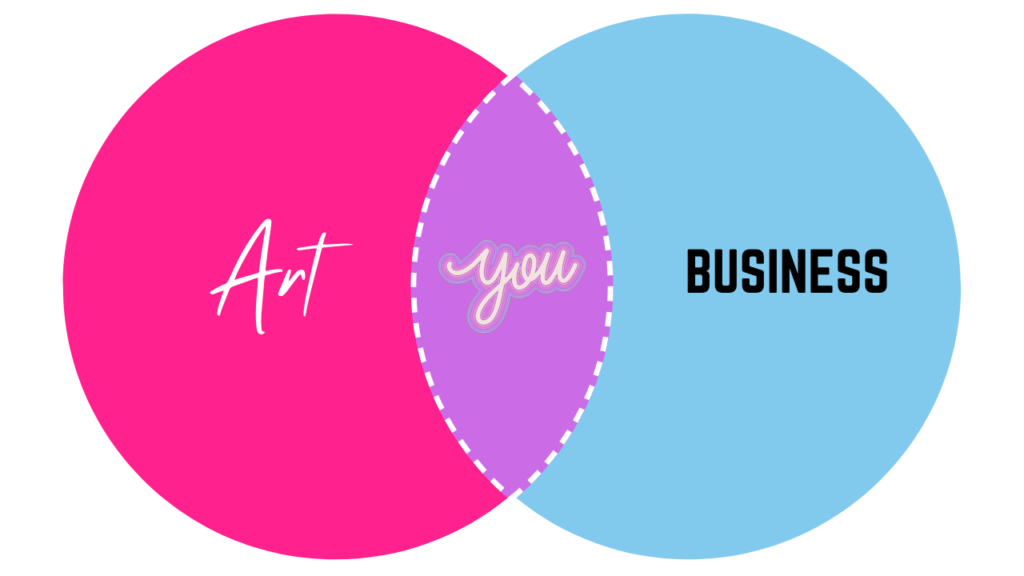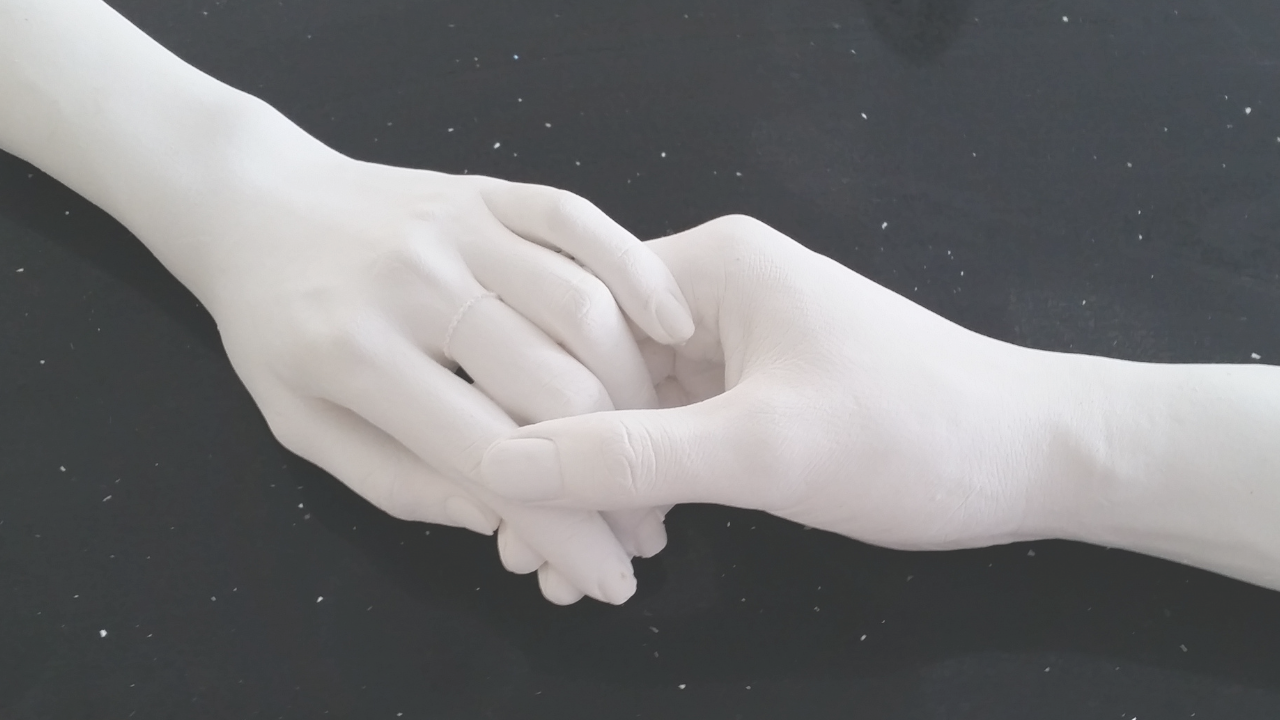Imagine getting up in the morning and jumping out of bed to start your day. You can’t wait to do your thing.
If you’re an artistic person, starting an art business can feel just that!
Fun, energizing, meaningful and joyful. Starting an art business from home can mean having a lifestyle you love.
If you’re passionate about art and life casting, I’m going to show you how to start an art business.
Here’s what you should know.
In every business there are 2 main parts.
The part where you have a thing to sell. And the part where you do the business to sell the thing.
You need to learn both. Art and business. Because you need both for it to work.

Most artists find it difficult to juggle both. Actually, most PEOPLE find it difficult to juggle both.
Usually, the business part is the hardest. People with amazing ideas have a talent or skill or product they want to sell. And they’re really good at doing the thing they want to sell. But they have little to no skills in business, so it’s hit or miss if they can make the business part successful.
But it doesn’t have to be hard. Anybody can learn basic business skills to create an art based home business
It’s just that most people haven’t learned that part well yet.
I love business. There’s an art and a science to it that makes it fun. I’ve been running my own businesses my entire life and have been studying and working with other businesses in sales, marketing and finance for over 40 years. Its just like any skill, the more you learn about it, the easier and more fun it can be.
So if you’re reading this, I’m going to assume you’re passionate about art. You want to create a lifestyle doing your art. And you want to share it with the world.
So the question is, how do you create a business with it?
I’ll tell you.
My best advice, find a mentor
When you want to learn a new skill there are two ways to do it. You can learn by trial and error – which will take up your time. Or you can learn from somebody else’s mistakes – which will most likely cost you money.
To me, my time is more valuable than my money. But you need to figure out what’s most important to you.
I would recommend finding somebody else that is doing what you want to do and get them to teach you how they do it. By following somebody else’s system, you can fast track your small business success.
If you can do that, do it.
Make a plan
The most common reason small businesses fail is because they don’t have a plan.

In the case of a life casting home business, your plan will revolve around marketing a local business. A local business strategy is a bit different than a national or global strategy.
But in most cases it’s a lot easier because you have less competition and less noise to deal with.
So, this is how to start an art business plan.
1. Know who would want to buy your thing.
The first part of your art business startup checklist is to know who would want to buy your stuff.
Not everybody will want what you have to sell. So you’ll need to figure out who your people are so that you can find them when you’re ready to market your business.
In the case of a Life Casting home business selling framed baby hand and feet, your people would be:
- new moms and dads
- relatives
- midwives and doulas
- friends
You should go a few more levels down. For example (these will vary based on your area):
- age range 25 – 40
- $70,000+ annual family income
- some cultures love family keepsakes more than others
Once you start selling your work, collect as much information about them as you can. It will make it easier to find more people just like them.
2. Figure out how you’re going to make money
Create a realistic monthly and yearly target amount you want to make. This is easier than it sounds.
Here, I’ll show you:
| Triple Window Shadow Box | $360 |
| Cost of supplies | $125 |
| Difference (Gross Profit) | $235 |
| Monthly Income Target | $2,000 |
| Target number of frames to sell per month | 9 |
| Target number of frames to sell per week | 2 |
Doable? Yes!
Especially when you can add other things to your business such as more sophisticated life casting pieces or even silver jewelry keepsakes.
Adjust the numbers to suit your situation.
You’ll have to add your ongoing expenses – website, Canva, maybe printing costs, advertising fees. But for the most part, these tools are inexpensive and you should be able to do local advertising on a shoestring budget.
3. Use business tools from the start
There are so many online tools it will make your head spin. It can be challenging to navigate through the sea of software. Especially because they all say that they’re the best!
So I’ll narrow it down for small business owners who are just starting. Keep it simple. You will evolve over time but start with the basics.
Here’s what you’ll need.
A Planning Tool
If you fail to plan, you should plan to fail. So here’s a tip.
Asana has a FREE PLAN to do your planning.
Set up Asana and keep it open on your computer. Every Sunday evening or Monday morning, look at your list and pick your top 2-5 priorities for the week. Then go back to your list throughout the week and work on those.
I like to organize my Asana list according to the following subheadings. You can add more detailed tasks under each heading.
- Priority To Do’s – move things to this section that need to get done next
- Business Finances – anything to do with bookkeeping, paying bills, or reviewing profits
- Online & Web Site – web site stuff like SEO or updates you need to do
- Social Media – I put ideas, designs, and my social media calendar in here. You can plan your social media posts in the Asana calendar to make this easier! Think Mother’s Day and other holiday promotions you should remember
- Offline Marketing – list the offline places you want to do (keep reading!)
- Long Term Ideas/Projects – a place to brain dump everything you might be thinking about for later
You can move the list items up and down the list. Categorize them and add due dates or high/low priority labels to each task.
Dump your ideas into the Long Term Ideas list if you’re up at night and have an idea (like me). That way it gets it out of your head so you don’t obsess or stress about it (also like me).
Later, when you look at your planning list, you can decide when to work on it.
Trust me this will save you time and help you grow. So put this together and check in and reorganize your list AT LEAST once a week. Easy right?
One other cool thing about Asana is that you can share your lists. If you’re working with somebody at some point, you can add them to your Asana lists and assign them tasks.
A Website with built in SEO
Creating a beautiful one page website has never been easier. Or more fun in my opinion. The top 3 most popular web builders (other than Shopify) are:
- Wix
- Squarespace
- GoDaddy
Why? All of them use templates and easy drag and drop programs. Just pick your favorite and fill in the blanks.
And all of them also have built in SEO. Just follow the prompts when you’re finished with your site design to set up your site to be SEO friendly.
A designing tool
You’ll need something to help you design stuff.
You’ll need to make a logo. Maybe you want to design some extra fun images on your website. Create social media posts and marketing postcards you can hand out.
Canva has a free version and a pretty inexpensive paid version and you can design pretty much ANYTHING. Plus it’s so fun to use!

They have templates you can customize or you start from scratch. Here’s a list of what I use Canva for:
- logos
- brand color ideas
- font pairing ideas
- social media posts in pre-formatted sizes and designs
- videos with text
- GIFS
- banners
- postcards
- business cards
- plus the paid version comes with thousands of stock photos that are licensed for you to use. So worth it!
Its another drag and drop type of app with a search bar so you can find everything you need. I love it and highly recommend using it for your business.
Asana, Wix and Canva would be the 3 things I would use to start my business. Or a variation of those 3.
That’s all you really need in the beginning.
The odd extra tool – later, when you’re ready
In the beginning you won’t have a lot of customers so you might not even need bookkeeping software yet.
Instead, you should have 1 credit card and 1 bank account set up JUST for your business expenses.
That way, at the end of each year you just print the statements to get your books and taxes done. It’s important to keep your business and personal expenses separate to keep this process as simple as you can.
In the meantime you can track your expenses using Google Sheets.
When your business starts growing you can add a few other tools such as
- Social media planning calendar such as Buffer or Later. Both are good
- Quickbooks Online
Once you have a dedicated credit card and bank account, set this up to import them into Quickbooks online and you’ve just saved yourself a ton of work. If bookkeeping is not your thing, find a legit bookkeeper to take those expenses and categorize them properly at the end of the year to do your taxes.
If you don’t like Quickbooks, Xero and Freshbooks do the exact same thing.
If you hate doing any of them, go to Fivver, search “set up quickbooks online”, check out the reviews (the more the better) and get somebody to do it for you. Once it’s connected to your accounts, you only need to go in there every month or two to make sure click the upload button and every sale and expense will be in there automatically.
You’re welcome.
Now that we’ve reviewed the tools, let’s get back to the next step of your plan.
4. Choose a business name
You’ll need a business name. To do that you need to keep something important in mind.
If somebody in your area is looking for you, and the only thing they see is your business name, will they know what you do?
Mike’s Plumbing or SD Interior Designs is straightforward and simple. Don’t pick a name like Nike or Apple (unless you have a multi million dollar marketing budget).
Your business name should at least give people a hint about what you do. That way, people kinda know what you do before you even tell them what you do. It makes your marketing job a lot easier.
5. Register your business
Every country has different systems and laws so this one is up to you to find. But all you really need to do is search for “register a business in [your country/region]”.
6. Create your brand
Your brand is just a fancy word for your style.

As a rule, a future customer needs to see you at least 7 times before they buy from you.
It’s like dating. You need at least 7 dates before you can ask them to marry you. Sometimes more!
When you date somebody, you get to know them. Their style. Their interests. Their values.
That’s what your brand is.
ALL of your stuff should have your “stamp” on it. Your website, social media, pictures, everything. Show off who you are using color, fonts, images, and the voice you use in your descriptions and content.
Be YOU! It used to be better to follow trends and give out highly polished and produced content. You still need to look professional. But content these days is more popular when it’s candid and transparent. More people now love authenticity.
So find your style and put that on everything you do.
7. Make it easy for people to find you
On a global scale, it’s hard to stand out. In a local market, not as much. That’s great news!
Although many of us focus a lot online, and you need to do that, in a local business you should spend as much time offline as you do online.
So that means, make a list of ALL the ways you can think of to get people to find you. Put that list in your Asana. Move them around from first to last according to what you want to do first. Then go down your list one at a time and try each one.
Here are some key things you need to do that are not online:
- Google search “[your town] chamber of commerce. Join that! Go to their events, lunch and learn days, become a member, talk to other local businesses. You’ll get tons of resources doing this. Whether you’re a social person or not, just do it.
- Network wherever you go
- Support charities
- Ads in local newspapers
- Get a booth at a local fair and do some live castings. You’ll get an audience when you do them! Make sure you have a sign up list to get people’s email addresses so you can contact them
- Ask if you can leave a stack of postcards with info about your business at different locations
- Create social media profiles. For local art work, Instagram and Pinterest are great. You’ll need to take good pictures of your work and post them. Videos are even better if you can. Our online LifeCasting Home Business course has an entire tutorial on taking great pictures of your art work using only your phone
By trying each of these local advertising strategies, you’ll get to know where your audience hangs out. Some will work better than others.
Keep doing what works and scrap the rest.
8. Make it yours! Go above and beyond in small ways.
The devil is in the details. It’s the little things.
“The difference between something good and something great is attention to detail.”
Charles R Swindoll, pastor & author
Here’s what I mean:
- Add a handwritten thank you note to every casting you create for a customer
- Wrap your finished castings in wrapping paper so it creates the experience of opening a gift
- Make your work special and original by adding extras such as birthstones, quotes, or calligraphy (if that’s your thing) to the front or back of your work
- Add your business logo, name and contact info in the form of a sticker to the back of every piece
- Partner with another artist or local business in your area to create a bundled deal or upsell. That could be jewelry, clothing, a photography session (which you can add to the frame) or anything else that might work well. Have an open mind and try different things!
Nurture your customers. A little extra thing might cost you a few extra bucks. But it will go a long way into making a great customer experience. Many times families that have multiple children will come back multiple times.
The Bottom Line
Creating an art home business is all about learning new skills that technically anybody can do if they want to.
If you look at your daily wins and losses as a reflection of who you are, you won’t get far. Try looking at successes and failures like finding the right pieces of a puzzle.

If you look at it that way, eventually you’ll create a beautiful picture. A life to be passionate about. And a successful art business.
Learn more about how to start an art business in mold making and check out my Life Casting Baby Hands & Feet Home Business online course.







0 Comments